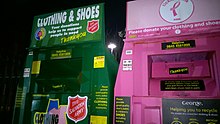The fashion industry has a disastrous impact on the environment. In fact, it is the second largest polluter in the world, just after the oil industry. And, the environmental damage is increasing as the industry grows. [1]

The textiles and fashion industries are amongst the leading industries that affect the environment negatively. One of the industries that greatly jeopardize environmental sustainability is the textiles and fashion industry, which thus also bears great responsibilities. Globalization has made it possible to produce clothing at increasingly lower prices, prices so low, and collections shifting so fast, that many consumers consider fashion to be disposable.[2] However, fast, and thus disposable, fashion adds to pollution and generates environmental hazards, in production, use, and disposal.
Putting the environmental perspective at the center, rather than the logic of the industry, is thus an urgent concern if fashion is to become more sustainable. The Earth Logic fashion research action plan argues for "putting the health and survival of our planet earth and consequently the future security and health of all species including humans, before industry, business, and economic growth."[3] In making this argument the Earth Logic plan explicitly connects the global fashion system with the 2018 IPCC Special Report on Global Warming of 1.5 °C.
Furthermore, the Earth Logic fashion research action plan sets out a range of possible areas for work in a sustainable fashion that scientific and research evidence suggests are the most likely to deliver a change of the scale and pace needed to respond to challenges like climate change. Earth Logic's point of departure is that the planet, and its people, must be put first, before profit. It replaces the logic of economic growth, which is arguably the single largest factor limiting change towards sustainable fashion, with the logic that puts earth at its center.[4]
Rethinking recycling edit

A more technologically-minded trend is "innovative recycling", which seeks to view waste itself as a source of value. Within the fashion industry, some[who?] manufacturers have created incentives for consumers to participate in the recycling of their clothing. Innovative recycling is also aimed at clothing stores themselves, who do not always have sustainable methods to properly dispose of boxes and plastic bags; innovative recycling also looks at the packaging that clothes come in having been sent from manufacturers. A change in approaches towards recycling within the fashion industry could potentially greatly impact the amount of waste the industry creates.[5]
 | This is a user sandbox of Fltuhol. You can use it for testing or practicing edits. This is not the sandbox where you should draft your assigned article for a dashboard.wikiedu.org course. To find the right sandbox for your assignment, visit your Dashboard course page and follow the Sandbox Draft link for your assigned article in the My Articles section. |
| This is the sandbox page where you will draft your initial Wikipedia contribution.
If you're starting a new article, you can develop it here until it's ready to go live. If you're working on improvements to an existing article, copy only one section at a time of the article to this sandbox to work on, and be sure to use an edit summary linking to the article you copied from. Do not copy over the entire article. You can find additional instructions here. Remember to save your work regularly using the "Publish page" button. (It just means 'save'; it will still be in the sandbox.) You can add bold formatting to your additions to differentiate them from existing content. |
Article Draft edit
Lead edit
Article body edit
References edit
- ^ "Environmental Impacts of the Fashion Industry". SustainYourStyle. Retrieved 2021-08-04.
- ^ Gwilt, Alison; Timo Rissanen (2011). Shaping Sustainable Fashion. Earthscan.
- ^ Fletcher, Kate; Tham, Mathilda (2019). Earth Logic Fashion Action Research Plan. London: JJ Charitable Trust. p. 33. ISBN 978-1-5272-5415-2.
- ^ Fletcher, Kate; Tham, Mathilda (2019). Earth Logic Fashion Action Research Plan. London: JJ Charitable Trust. p. 19. Archived from the original on 2020-02-26. Retrieved 2020-02-26.
- ^ "Trend report: Future of Sustainable Fashion" (PDF). Archived from the original (PDF) on 2018-03-21.